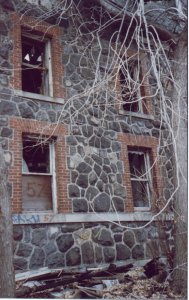The New York City Farm Colony – Seaview Hospital
Historic District
The New York City Farm Colony – Seaview Hospital Historic District, the
first historic district in Staten Island, was designated in 1985. The district
consists of the buildings and grounds of two municipal institutions sited on
approximately 320 acres at the center of Staten Island. The two institutions
lie across Brielle Avenue from one another. For two short periods in their
history they fell under the same administration, but they were founded
separately – The Seaview Hospital as a tuberculosis hospital, the Farm
Colony as a poor farm.
Go to more
information on the Seaview Hospital part of the Historic District.
 |
In 1902 a predecessor charitable institution, the Richmond County Poor
Farm, was renamed The New York City Farm Colony. Its purpose and assets were
described as follows: " …as to the New York City Farm
Colony…much can be said of its importance to the City. While the inmates
at other institutions under the Department of Public Charities look around and
have nothing whatever to do, here they pay for their board twofold by their
labor, working on the farm raising vegetables, not only for themselves, but for
other unfortunates. No healthier spot within miles of Greater New York can be
found, situated on the western slope of Todt Hill, the highest land in Greater
New York – it being 368 feet above sea level – a beautiful site with
its fertile fields, where any kind of vegetable thrives. All it needs is
cultivation…"
The character of this historic complex is absolutely unique in the City of
New York. Gambrel-roofed dormitories and service buildings of fieldstone and
brick were built between 1904 and 1916. Extreme care was taken to place these
solid structures strategically in the landscape. This sensitive site planning
resulted in preserving the rural landscape and views often by hiding the
buildings with slopes and/or complementing the terrain by their shape and
height. The use of the Dutch Colonial Revival Style maintained the continuity
of local architectural traditions and created a unified complex.
|
The first building, known as Dormitory 1 & 2 was designed by the firm of
Renwick, Aspinwall & Owen and was opened in 1904. It formed the prototype
for subsequent dormitories and service buildings constructed prior to the
1930s. The recently demolished building - Dormitory 3 & 4 was the second
building constructed in the Farm Colony. It was designed by William Flanagan
and completed in 1909. See Preservation Alert!
The recent history of the Farm Colony is pretty dismal. The last residents
were removed in 1975. Beginning in 1980, the city has repeatedly tried to sell
land within the historic district for development, despite the protests of
Staten Island environmentalists, who are committed to making the unbuilt land
part of the Greenbelt, and of preservationists, whose aim is adaptive reuse of
the buildings.
In 1983, a City Planning Commission report recommended adaptive reuse of the
12 buildings and "a preservation of open spaces surrounding the
buildings." That same year, the borough president’s commission for
the Greenbelt issued a report recommending that the city "should not offer
this property with any inclusive new development rights (no construction of
additional residential or commercial units)."
In 1984, 22 of approximately 95 acres were transferred to the Parks
Department to be included in the Greenbelt.
In 1988, the city issued an "request for expressions of interest"
for purchase and development of the Farm Colony Site, approximately 75 acres
called "Woodlands, NYC" in their rather fancy booklet. The request
called for residential development along with renovation of the historically
and architecturally distinct buildings. This plan was vigorously opposed by
environmentalists and preservationists and apparently went nowhere.
In 1999, the New York City Economic Development Corporation issued a Request
for Proposals to construct senior housing on the forested land to the north of
Seaview Hospital. Staten Island’s environmental advocates "The
Protectors of Pine Oak Woods" unequivocally oppose this plan and have
filed suit against the city.
Over the years, there have been arson-related fires at the Farm Colony.
Roofs are gone, leaving the buildings open to continuing deterioration.
last revised September 6 1999
by Preserve & Protect
